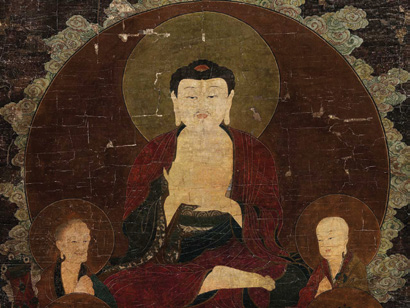An Illustrated Outline of Buddhism: The Essentials of Buddhist Spirituality (9 page)
Read An Illustrated Outline of Buddhism: The Essentials of Buddhist Spirituality Online
Authors: William Stoddart,Joseph A. Fitzgerald
Tags: #Philosophy


Life of the Buddha, Origin of Buddhism
17
Vajrachchedikā-Sūtra
(the “Diamond Sūtra”), the
Sukhāvatī-Sūtra
(the
“Pure Land Sūtra”), the
Saddharma-Pundarīka-Sūtra
(the “Lotus of
the Good Law Sūtra”), and the
Lankāvatāra-Sūtra
(the “Manifestation
in Lankā Sūtra”).
About 483 B.C., at the age of eighty years, the Buddha died
at Kushinagara (the present-day Kasia, near Gorakhpur, in Uttar
Pradesh). This was his final “expiration” (
Parinirvāna
). His last words
were: “Decay inheres in all created things. With clear mind give due
heed to your salvation.”
Page from the
Prajñā-Pāramitā-Sūtra
, depicting Shākyamuni Buddha (
left
)
and Prajñāpāramitā
(
right
), Tibetan script, 13th century
Namo tassa Bhagavato Arahato Sammā-sambuddhassa!
Homage to the Blessed, the Worthy, the Ful y-Enlightened!
Buddham saranam gacchāmi;
To the Buddha, the refuge, I go;
Dhammam saranam gacchāmi;
To the Dharma, the refuge, I go;
Sangham saranam gacchāmi.
To the Sangha, the refuge, I go.
Ti-sarana-gamana


18
An Illustrated Outline of Buddhism
The Blessed One said:
“
Know, Varatha, that from time to time
a
Tathāgatha
(
a
‘
Thus-Gone
’
or a
‘
Fully-Arrived
’)
is born into
the world, a ful y Enlightened One, blessed and worthy, abound-ing in wisdom and goodness, happy with the knowledge of the
worlds, unsurpassed as a guide to erring mortals, a teacher of
gods and men, a Blessed Buddha. He thoroughly understands
this universe, as though he saw it face to face. . . . The Truth does
he proclaim, in both its letter and its spirit—lovely in its origin,
lovely in its progress, lovely in its consummation. A higher life
does he make known, in all its purity and perfection.
”
Tevijja-Sutta
Shākyamuni Buddha with disciples Mahākāshyapa and Ānanda,
ink and color on silk, Ming Dynasty, China, c. 15th-16th century


19
(6) Some Early Buddhist Figures
Mahākāshyapa
(sixth-fifth centuries B.C.)
After his enlightenment, the Buddha proceeded to Rājagriha where
King Bimbisāra put the Bamboo Grove (
Venuvana
)
at his disposal.
While there, Shāriputra and Maudgalyāyana (devotees of the Hindu
teacher Sanjayin) became acquainted with one of the Buddha’s disci-
ples, who conveyed to them the essence of his master’s doctrine in the
famous verse:
Of all things proceeding from a cause, the cause has been
shown by Him-thus-come; and their cessation too the Great
Pilgrim has declared.
Saddharma-Pundarīka-Sūtra
, 27/
Mahāvagga
, 1:23
This caused the two immediately to convert, and they soon be-
came leading disciples of the Buddha. In images, they are often depict-
ed on either side of the Buddha. They died shortly before the Buddha
himself.
The group at the Bamboo Grove was also joined by the brahmin
Pippali, later known as Kāshyapa, who likewise converted and in due
course became the Buddha’s principal disciple. Following the Bud-
dha’s death, Kāshyapa took over the leadership of the community
(
sangha
). Kāshyapa (called Mahākāshyapa, “the great Kāshyapa”) had
been the only disciple to understand the Buddha’s famous “flower ser-
mon”. It is said that once the god Brahmā appeared to a gathering of
the disciples on Mount Gridhrakūta (“Vulture Peak”) near Rājagriha
and asked the Buddha to expound the
dharma.
The Buddha, instead
of giving a discourse, merely held up a flower. None of those present
understood what this meant, except Kāshyapa, who responded with a
smile. The Buddha then said: “The true
dharma
cannot be expressed
through words or letters; it is a special transmission outside the writ-
ten scriptures; this transmission I entrust to Kāshyapa.” It was thus that
Mahākāshyapa became the first Indian patriarch of
Dhyāna
,
Ch’an
,
or
Zen
Buddhism. Starting with him, the supra-formal
dharma
was
transmitted by twenty-eight Indian patriarchs down to Bodhidharma,
a South Indian prince, who went to China in 520 A.D. and became the
first patriarch of
Ch’an
in that country. (See p. 53.)

20
An Illustrated Outline of Buddhism
Ānanda
(sixth-fifth centuries B.C.)
Ānanda was a cousin of the Buddha, and another of his leading disciples.
It was at his intercession that the Buddha consented to the founding of
an order of nuns. His extraordinary recall of the Buddha’s discourses
was the basis of the codification of the earliest Buddhist Scriptures.
Ānanda became the second Indian patriarch of
Dhyāna
Buddhism. In
the main hall of many Chinese monasteries, there is an image of the
Buddha, with Kāshyapa on his right and Ānanda on his left.
Ashoka
(third century B.C.)
Ashoka, a scion of the Hindu Mauryan Dynasty, was king of the an-
cient North Indian kingdom of Māgadha (corresponding approxi-
mately to the modern Bihar), who converted to Buddhism. Following
his warlike earlier years, when he conquered much territory and ac-
quired dominion over the greater part of the Indian sub-continent, he
became one of the greatest and most saintly rulers in Indian history;
his avowed intention was to establish a “reign of
dharma
”.
He was the
most benevolent of monarchs, watching careful y over the well-being
of his subjects, and maintaining friendly relations with neighboring
states. His son Mahinda was instrumental in taking Buddhism to Cey-
lon (now Sri Lanka), and under Ashoka’s influence Buddhism also
spread in Burma. His famous “edicts” enshrine the precepts that he
propagated. For example: “Never think or say that your own religion is
best; never denounce the religion of others. He who does reverence to
his own sect, while disparaging the sects of others . . . and with intent
to enhance the glory of his own sect, in reality by such conduct inflicts
the severest injury on his own sect.”
Milinda
(c. first century B.C.-first century A.D.)
Milinda is usual y identified with the Greco-Indian King Menander,
who, around the turn of the millennium, conquered a large tract of
Northern India. Milinda posed a number of questions regarding Bud-
dhism to the monk Nāgasena, and the latter’s answers are said not only
to have converted Milinda to Buddhism, but henceforth, in the form of
the treatise
Milindapañha
(“The Milinda Questions”) became an im-
portant source of
Theravāda
perspectives on some of the central theses
of Buddhism, such as
karma
and
anātmā
.

